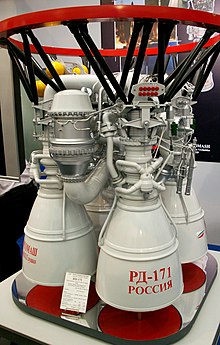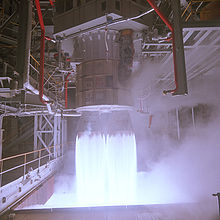RD-170
The RD-170 (from Russian Реактивный двигатель , "Reaktiwny Dwigatel") ( GRAY index 11D521) is a rocket engine for liquid rockets . It was developed by the Soviet chief designer for rocket motors Valentin Petrovich Glushko between 1976 and 1986 at the Leningrad Gas Dynamics Laboratory (now NPO Energomasch ). The four boosters of the Energija rocket were each powered by an RD-170, the RD-171 derived from it is the main engine of the Zenit rocket in the first rocket stage . The RD-170 is still the most powerful liquid rocket engine ever flown.
technology


The RD-170 was operated with kerosene and liquid oxygen (LOX) and consisted of four main combustion chambers , which shared a turbine with an output of around 190 MW and a pump set . The energy required to drive the turbine was provided by oxygen-rich pre-combustion in two gas generators or pre-combustion chambers. For this purpose, the entire amount of the oxidizer and a small part of the fuel were added, which burned at a low temperature and drove the turbine. The exhaust gas from the pre-combustion chamber then went to the main combustion chambers, where most of the fuel was fed and burned. By this design, a so-called main turbofan engine with simple pre-combustion ( English oxidizer rich staged combustion cycle ) was the engine even at the high combustion chamber pressure of 25 MPa no fuel to power the pumps lost, which would otherwise have led to considerable losses. At the same time, the preheating of the cryogenic oxygen in the pre-combustion improved the efficiency of the combustion and reduced the risk of instabilities in the combustion, which could otherwise lead to vibrations. Nevertheless, the engine had to struggle with problems at the beginning during tests, since at 25 MPa pressure and 400 ° C inlet temperature in the main combustion chamber an oxygen-rich atmosphere is difficult to control; the three SSME engines of the space shuttle operate at 22 MPa with fuel-rich pre-combustion, the RD-253 operates at only 15 MPa. Another special feature of the engine was that the thrust could be reduced significantly (depending on the source to 40% or 56% of the nominal value) in order to reduce the acceleration and thus the load on the rocket structure before the burnout.
In contrast to the Soyuz rocket , the engine made it possible to dispense with additional control engines, as the RD-170 for the Energija can pivot the nozzles around an axis. The derived RD-171 (11D520) for the Zenit has a two-axis control (in use up to 6.3 °, in tests over 8 °) of the nozzles for this purpose.
The Energija's four boosters with RD-170 engines were designed to be reusable and equipped with parachutes. The engines should be able to withstand up to ten starts, with tests showing that they can withstand 20 starts.
Some sources put the Zenit-3SL's engine as RD-173 with a thrust increased to 7,695 kN / 8,338 kN, whereby the manufacturer calls this RD-171M .
The RD- 170 engine is used as the RD-180 (only two combustion chambers, 25.7 MPa combustion chamber pressure and 4,159 kN thrust) on the American launch vehicles Atlas-III and Atlas V , as the RD-191 (only one combustion chamber, 25, 7 MPa combustion chamber pressure, 3,230 kg mass and 2,079 kN thrust) on the Angara rocket .
A modified version of the RD-191 for the Antares missile is designated as the RD-181 . In December 2014, the contract for the delivery of 60 engines was signed.
Under the designation RD-193 , a variant for Soyuz 2.1 was developed as a replacement for the NK-33 engines. The development was announced in August 2011, the first tests will take place in mid-2012 and in 2013 it was announced that the test series had been completed. The engine was to be 760 mm shorter and 300 kg lighter than the RD-191.
Technical specifications
| RD-170 / RD-171 | RD-180 | RD-191 | RD-193 | |
|---|---|---|---|---|
| Mixing ratio LOX / kerosene | 2.63 | 2.72 | ≈2.6 | |
| Combustion chambers | 4th | 2 | 1 | 1 |
| Total height | 3.78 m | 3.00 m | 4.05 m | 3.02 m |
| diameter | 4.02 m | 3.56 m | 2.00 m | 2.10 m |
| Dry matter | 9,500 kg (9,750 for RD-171) | 5,393 kg | 3,230 kg | 2,900 kg |
| Mass / thrust ratio (ground / vacuum) | 1.26 / 1.20 kg / kN | |||
| Combustion chamber diameter | 380 mm | ? mm | ? mm | |
| Combustion chamber pressure | 24.5 MPa | 25.7 MPa | 25.7 MPa | |
| Nozzle throat diameter | 235.5 mm | ? mm | ? mm | |
| Nozzle end diameter | ≈1430 mm | ? mm | ? mm | |
| Nozzle end pressure | 0.072 MPa | ? MPa | ? MPa | |
| Expansion ratio | 36.87 | 36.87 | 37 | |
| Floor thrust / vacuum thrust | 7,550 / 7,900 kN | 3,828 / 4,152 kN | 1,985 / 2,079 kN | ? /2,085 kN |
| Specific impulse (soil / vacuum) | 3030/3315 Ns / kg | 3306 Ns / kg |
Web links
- RD-170 in the Encyclopedia Astronautica (English)
- RD-170/171 (Russian)
- RD-180 (Russian)
Individual evidence
- ↑ Bernd Leitenberger: The Zenit carrier rocket. Retrieved July 9, 2008 .
- ↑ RD-170 - Specifications. Andrews Space & Technology, archived from the original on July 25, 2008 ; accessed on July 9, 2008 (English).
- ↑ RD-173 in the Encyclopedia Astronautica , accessed July 9, 2008 (English).
- ↑ РД-170/171. NPO Energomash, accessed July 9, 2008 (Russian).
- ↑ russianspaceweb.com: Angara's engine gets a job in the US , accessed August 1, 2015
- ↑ deagel.com: RD-181 , accessed August 1, 2015
- ↑ russianspaceweb.com: RD-193 engine , accessed August 1, 2015
- ↑ Spaceflight101: Soyuz 2-1v - Spaceflight101 , accessed on August 1, 2015

